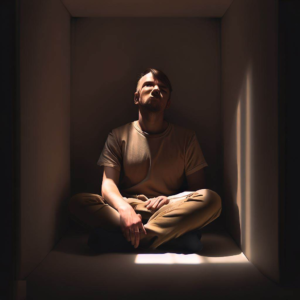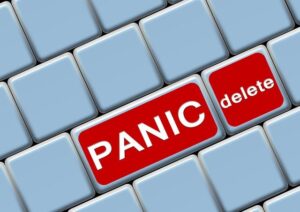Claustrophobia is a widespread anxiety disorder that affects millions of individuals across the globe. It is characterised by a phobia of small or confined spaces, such as lifts, aeroplanes, and tunnels. Individuals with claustrophobia experience panic attacks and extreme anxiety in these situations, frequently resulting in avoidance behaviours that can have a significant impact on their daily lives.
If you suffer from claustrophobia, you understand how incapacitating it can be. The good news is that it is possible to overcome your fears and live a fulfilling life with the proper management techniques and support.
This article will discuss the nature of claustrophobia, its symptoms, and how to deal with panic attacks and anxiety in confined spaces. Whether you are seeking assistance for yourself or a loved one, this guide attempts to provide helpful information on how to cope with this difficult condition.
Understanding the Causes and Symptoms of Claustrophobia
 Understanding claustrophobia is essential for coping with panic attacks and anxiety that may result from being in confined spaces. Claustrophobia is an anxiety disorder characterised by an extreme aversion to enclosed or confined spaces. The causes of this condition can vary, but traumatic experiences, genetic predisposition, and learned behaviour are common triggers.
Understanding claustrophobia is essential for coping with panic attacks and anxiety that may result from being in confined spaces. Claustrophobia is an anxiety disorder characterised by an extreme aversion to enclosed or confined spaces. The causes of this condition can vary, but traumatic experiences, genetic predisposition, and learned behaviour are common triggers.
It is crucial to note that claustrophobia affects individuals differently, with some experiencing physical symptoms and others experiencing only emotional responses. Among the physical manifestations of claustrophobia are perspiration, a rapid pulse, shortness of breath, chest tightness or discomfort, dizziness or lightheadedness, trembling or shaking. The body’s natural fight-or-flight response causes these responses when it perceives peril.
Mental symptoms, on the other hand, can manifest as feelings of dread or terror, a sense of losing control or going insane, and even thoughts of mortality. Notably, physical and mental symptoms are not mutually exclusive; they frequently co-occur during claustrophobia episodes.
Understanding the various types of symptoms is crucial for identifying the causes of panic attacks and anxiety in confined spaces. In the following section, we will examine how to recognise these triggers and develop strategies to effectively manage them without medication.
Claustrophobia Coping Strategies: Breathing And Relaxation Techniques
Utilising respiration and relaxation techniques is one of the most effective coping mechanisms for claustrophobia.
It is common for people with claustrophobia to experience a panic attack when confronted with a small or enclosed space. It is essential to practise deep breathing exercises that can help soothe the mind and body in order to manage these attacks.
Yoga poses are an additional technique that can aid in the management of claustrophobia. Certain yoga postures, including child’s pose, forward fold, and pigeon pose, can aid in relieving muscle tension and promoting relaxation. Additionally, regular yoga practise can reduce overall stress and enhance sentiments of well-being.
Visualisation techniques can also aid in the management of claustrophobia-related anxiety. Imagining oneself in a tranquil environment or engaging in a calming activity can provide a sense of control and a distraction from feelings of panic. It is essential to routinely practise visualisation techniques so that they become automatic responses to claustrophobia-related triggers.
Individuals with claustrophobia can reduce the frequency and severity of their panic attacks and improve their ability to manage anxiety in confined spaces by incorporating these coping strategies into their daily routine. With persistence and perseverance, these techniques can become second nature, enabling individuals to live more freely and without dread of enclosed spaces.
Exposure Therapy: Confronting Your Fears In A Safe Setting
Have you ever felt fear paralysing you in a tiny, confined space? Claustrophobia can be a debilitating condition that restricts daily activities and triggers panic attacks.
However, through exposure therapy, this phobia can be transcended.
Exposure therapy entails confronting your anxieties in a safe environment, such as through virtual reality or desensitisation exercises. You can progressively reduce your anxiety and develop coping mechanisms through repeated exposure to the feared situation.
Virtual reality technology enables simulations of confined spaces to be experienced in a safe and controlled environment. It allows you to confront your fears without actual danger, making it simpler to deal with anxiety.
Similarly, desensitisation exercises consist of gradually exposing oneself to smaller and smaller spaces until they become comfortable. These techniques can help alleviate claustrophobia symptoms and enhance your quality of life with time and practise.
Remember that overcoming claustrophobia requires perseverance and time. Exposure therapy is not an instantaneous cure, but rather a gradual recovery procedure. It is essential to collaborate with a mental health professional who specialises in this type of treatment to ensure that you are achieving your objectives in a safe and effective manner.
Therapy And Medication Options When Seeking Professional Help
When it comes to managing claustrophobia, it can be extremely beneficial to seek professional assistance. Common treatments for individuals with anxiety and panic attacks in confined spaces include psychotherapy and medication.
Medication is frequently used as a short-term solution to manage claustrophobia symptoms. A healthcare provider may prescribe various medications, such as antidepressants and anti-anxiety drugs. It is essential to note, however, that medication alone may not provide long-term relief and that therapy should be used in conjunction with medication.
Individuals struggling with claustrophobia can receive long-term benefits from therapy, however. Individuals can investigate their thoughts and feelings regarding their phobia of small spaces in a safe and supportive setting.
Finding the correct therapist is essential for treatment success. It is essential to find a professional who specialises in treating anxiety disorders and has experience working with claustrophobia patients.
With the proper therapist and consistent effort, therapy can assist patients in developing coping mechanisms and regaining control over their symptoms.
Tips For Long-Term Management And Prevention Of Claustrophobia
Did you know that approximately 5-7% of the population suffers from claustrophobia? Small or enclosed spaces can provoke this common anxiety disorder.
Anxiety and panic attacks may feel overwhelming, but there are methods to manage these symptoms and prevent them from interfering with your daily life.
Self-care is an essential aspect of claustrophobia management. This involves caring for your physical, emotional, and mental health.
Exercise, meditation, deep breathing techniques, and massage therapy are a few examples of stress-relieving and relaxation-inducing activities. It is also essential to participate in activities that offer you joy and satisfaction, such as reading or pursuing a hobby.
Changes in lifestyle can also play a significant role in preventing panic attacks and claustrophobia-related anxiety. It is crucial to gradually expose yourself to these situations through desensitisation techniques, under the supervision of a mental health professional.
In addition, reducing caffeine consumption and avoiding alcohol and drugs can help modulate mood and prevent symptom exacerbation. By incorporating these self-care practises and lifestyle modifications into your daily routine, you will be able to gain control over your claustrophobia and live a fulfilling life free from dread.
How prevalent is claustrophobia, and who is most susceptible to developing it?
Understanding the aetiology of claustrophobia is greatly influenced by prevalence and risk factors.
Up to seven percent of the population will experience the condition at some stage in their lives.
Genetic predisposition, traumatic experiences, and preexisting anxiety disorders are risk factors.
In addition, those who have experienced a lack of control over their environment or who have a heightened threat perception may be more susceptible to developing claustrophobia.
A comprehensive evaluation by a mental health professional can help identify these risk factors and guide treatment decisions for those afflicted with this disorder.
Can Claustrophobia Be Cured Permanently, Or Is It Something That Must Be Managed Long-Term?
I am frequently asked whether claustrophobia can be wholly cured or if it requires long-term management.
Some people may eventually overcome their dread of small spaces, but others may need ongoing management and coping strategies.
The key to long-term management of claustrophobia is identifying triggers and developing individualised, effective coping strategies.
This could consist of relaxation techniques, exposure therapy, or cognitive-behavioral therapy.
Remember that seeking assistance from a mental health professional can greatly improve your odds of long-term claustrophobia management success.
Does Claustrophobia Respond to Any Natural Remedies Or Alternative Therapies?
Herbal remedies and breathing techniques can aid in the management of claustrophobia symptoms.
Certain botanicals, including valerian root and passionflower, have been shown to have calming effects on the body and can be consumed as a supplement or tea.
Breathing techniques, such as deep breathing and progressive muscle relaxation, can also aid in anxiety reduction and relaxation.
Despite the fact that these natural remedies may provide some alleviation, they should not be used as a replacement for professional care.
Individuals can work with a mental health therapist or clinical psychologist to devise a personalised strategy for long-term claustrophobia management.
How Can Family And Friends Help Someone With Claustrophobia?
When assisting someone with claustrophobia, it is essential to demonstrate compassion and understanding.
A client of mine who suffered from severe claustrophobia and could not stand the thought of riding a lift is one example. Her spouse would frequently accompany her up the stairs, even if it meant being late for appointments. This modest but supportive gesture significantly improved her ability to manage her anxiety.
Additionally, therapy sessions can be extremely beneficial for both the claustrophobic individual and their loved ones. Together, they can discuss their fears and devise coping strategies.
In the end, it is essential to keep in mind that support and patience are essential for assisting someone with claustrophobia to surmount their anxiety.
Can other phobias or anxiety disorders be related to claustrophobia or make it worse?
Associated phobias and anxiety disorders can definitely contribute to or exacerbate claustrophobia.
For instance, agoraphobia, the dread of open spaces, can exacerbate claustrophobia by creating a sense of confinement if the sufferer is unable to escape.
In addition, social anxiety disorder may contribute to claustrophobia because crowded spaces or situations involving a large number of people may provoke panic attacks or feelings of being trapped.
Exposure therapy and cognitive-behavioral therapy are effective coping mechanisms for treating claustrophobia and related phobias or anxiety disorders.
Claustrophobia is a prevalent phobia that impacts a sizeable percentage of the population. Some individuals may never be completely cured, despite the fact that it can be managed with treatments such as exposure therapy and medication. It is essential to remember, however, that everyone’s experience with claustrophobia is unique and there is no one-size-fits-all solution.
As mental health professionals, we frequently employ the metaphor of a journey to characterise the process of claustrophobia management. As with any journey, there will be ups and downs, but with the proper support and resources, one can learn to navigate through challenging moments.
It is essential for loved ones to offer compassion and understanding to those with claustrophobia as they embark on their individual healing journey. Remember that you are not alone on this journey and that there are resources available to assist you.





